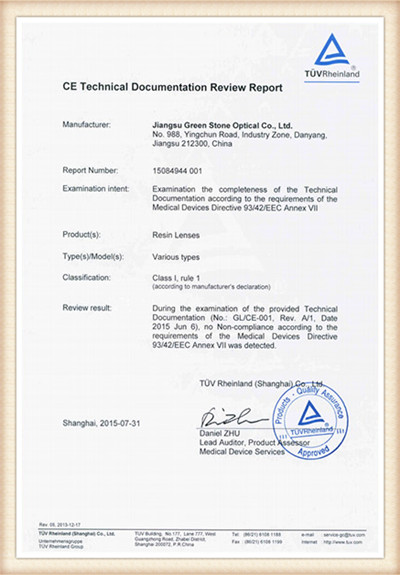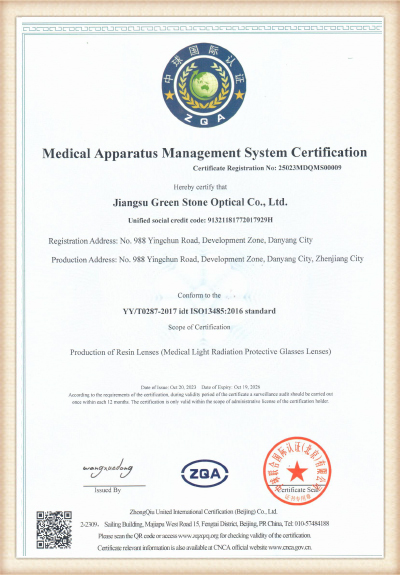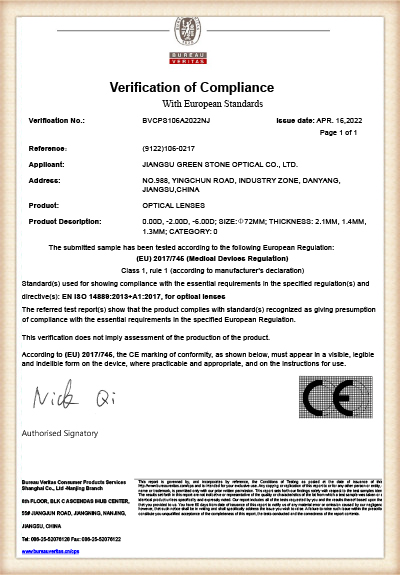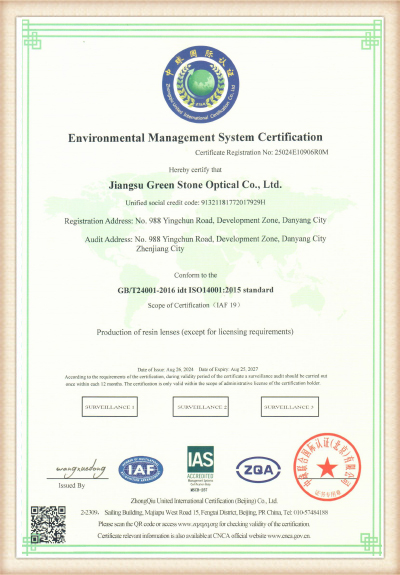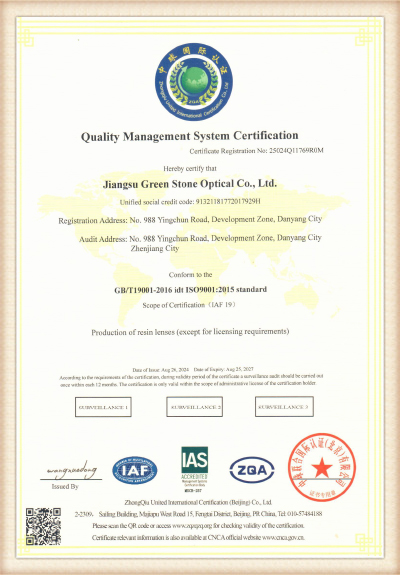Introduction to Core Concepts: The Purpose of Polarized and Photochromic Lenses Advanced lens technologies are designed to enhance visual comfort and protect the eyes from harmful light. Among the many high-quality options, Polarized Lenses and Photochromic Lenses are two of the most popular choices, yet they address d...
READ MORE
Product Series
Occupational Lenses Designs Manufacturers
-


Desk 2.0 Occupational Lens
New and improved updated design Custom Desk 2.0 offers even wider fiel... -


Professional 2.0 Occupational Lens
NEW Professional lens design Custom Professional 2.0 is an occupationa...
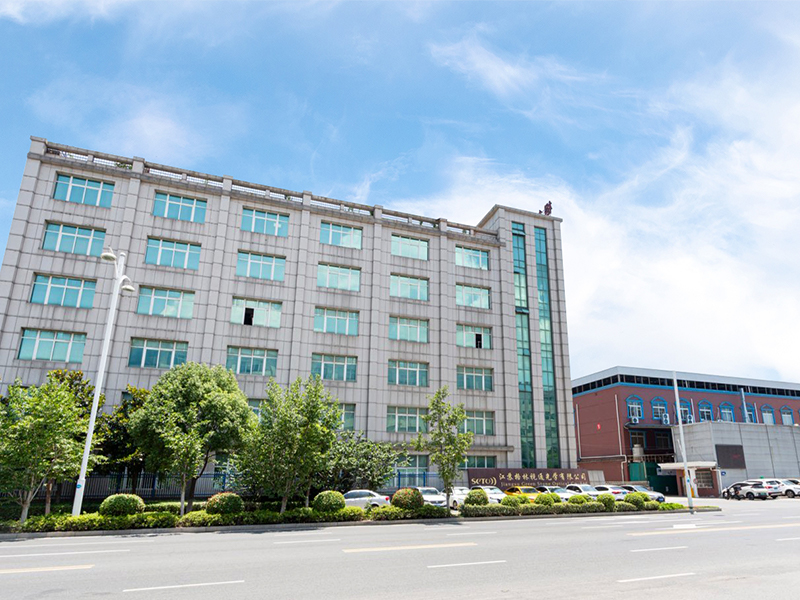
Our lens products involves almost all types of lenses. Product range covers 1.499, 1.56, 1.60, 1.67, 1.70 and 1.74 index, including single vision,bifocal, progressive, blue cut, Photochromic, blue cut photochromic, Infrared cut etc. with HC, HMC and SHMC treatment. Besides finished lens, We also manufactures semi-finished blanks. The products are registered with CE&FDA and our production certified by ISO9001& ISO14001 standards.
We positively introduce excellent management technology, comprehensively import Corporate Identity System and enhance the external image of company and brand.
-
-
Introducing Normal Lenses and Defocus Lenses In the fields of optics and image capture, the lens is a core component responsible for guiding and shaping light to form an image on a sensor or retina. While all lenses are based on the same laws of physics, their design goals and final effects can vary widely. This articl...
READ MORE -
Unveiling the Technology of Bifocal Lenses Introduction to Bifocal Lenses A bifocal lens is a powerful and time-tested solution in vision correction. Simply put, it is a corrective lens that contains two distinct optical powers within a single lens surface. This design addresses a common challenge faced by millions: ne...
READ MORE
What Are the Differences Between Occupational Lenses Designs and Regular Single Vision or Progressive Lenses?
Purpose and customization:
With the diversification of modern work styles and increasing visual demands, occupational lenses (Occupational Lenses Designs) have become an important branch of the optical industry. Compared with traditional single vision lenses or regular progressive lenses, occupational lenses not only correct vision but also optimize for specific work environments and visual tasks. Jiangsu Green Stone Optical Co., Ltd., as a professional optical lens manufacturer, leverages advanced production equipment and comprehensive optical design technology to provide tailored visual solutions for various occupational groups.
Differences from regular lenses:
Regular single vision lenses are primarily used to correct myopia or hyperopia, with a fixed focal point suitable for a single viewing distance, while progressive lenses provide a continuous change in optical power, enabling seamless vision at far, intermediate, and near distances, suitable for presbyopic or multi-distance needs. However, modern office workers, teachers, doctors, and engineers have more complex visual requirements: long-term computer use, intermediate document handling, and close-up precision tasks all require specialized distance optimization. Occupational lenses optimize different visual zones based on usage scenarios, reducing eye accommodation burden and improving work efficiency and comfort.
Advantages over regular progressive lenses:
Although regular progressive lenses offer multi-focal vision correction, their intermediate or lower visual zones are limited in clarity, often causing neck strain or discomfort. Occupational lenses, through precise optical calculations and design, expand the intermediate and near zones, allowing users to naturally access the required viewing distance without frequent head tilting or lifting. For example, Jiangsu Green Stone Optical Co., Ltd.'s occupational lenses optimize the intermediate zone on the basis of progressive design, significantly improving wearer comfort.
Functional enhancements:
Functional treatments are also critical in occupational environments. Regular lenses usually provide basic anti-reflective coating, while occupational lenses integrate high-strength HC (hard coating), HMC (multi-layer anti-reflective), and SHMC (super hydrophobic anti-smudge and anti-reflection) treatments, along with blue-light protection, photochromic, infrared-cut, and combined functionality. For instance, office workers exposed to screens and digital devices for long hours can benefit from blue-light protective occupational lenses to reduce eye fatigue and dryness, while blue-light photochromic lenses or photochromic lenses maintain visual comfort in changing light conditions. Jiangsu Green Stone Optical Co., Ltd. provides a diversified combination of functional lenses to meet the needs of different industries and occupational scenarios.
Comfort and customization:
Occupational lenses also excel in wearer comfort. By selecting lens indices (1.499, 1.56, 1.60, 1.67, 1.70, 1.74), they achieve both optical precision and reduced thickness, minimizing frame pressure and nose bridge burden. Jiangsu Green Stone Optical Co., Ltd. possesses advanced production technology and molds to provide high-index occupational lenses that are both aesthetically pleasing and comfortable for all-day wear.
Application for different professions:
The core advantage of occupational lenses lies in customization for specific professions. Whether it is teachers frequently switching focus between the blackboard and textbooks, doctors requiring precise intermediate and near vision for surgery or examination, or engineers performing long-term computer-aided design, occupational lenses combine optical design, focal zone optimization, and coating functionalities to achieve optimal visual performance. Jiangsu Green Stone Optical Co., Ltd. provides both finished occupational lenses and semi-finished blanks, offering flexible customized solutions for partners to ensure every lens precisely meets the wearer’s professional requirements.
Quality assurance:
To ensure reliability and safety, all products of Jiangsu Green Stone Optical Co., Ltd. are CE and FDA registered, with production strictly following ISO9001 and ISO14001 standards. High-quality materials, precise manufacturing processes, and stringent quality control ensure long-term stable performance while delivering excellent visual experiences.
Summary of differences:
The key differences between occupational lenses and regular single vision or progressive lenses lie in targeted design, comfort optimization, and functional enhancement. By providing precise distance adjustment, expanded intermediate and near zones, functional coating treatments, and thin, lightweight materials, occupational lenses offer more efficient and comfortable vision for various professional groups.
How Does Eye Movement Trajectory Affect Occupational Lenses Design?
Eye movement types and professional needs:
Eye movement mainly includes three types: horizontal and vertical rotations, accommodation adjustment, and micro-movements. Different occupational scenarios require the eyes to quickly switch between far, intermediate, and near distances, often accompanied by frequent up-and-down or side-to-side movements. For example, in office environments, users’ eyes constantly switch between computer screens and documents; teachers frequently shift focus between the blackboard and textbooks; engineers need to perform continuous precise tracking during drawing or design work.
Impact on visual focus:
The trajectory of eye movement directly determines the position of the visual focus on the lens. If the lens optical design does not consider the natural movement of the eye, it may cause blurred progressive zones, visual jumps, neck fatigue, or increased eye accommodation strain, thereby affecting professional efficiency and comfort.
Design strategies:
Occupational progressive lenses must consider eye movement in their design. By optimizing the width and position of the intermediate and near zones, adjusting the curvature and slope of the progressive corridor, and allowing for personalized customization, designers can reduce distortion and ensure smooth visual transitions for users in different professional scenarios.
Role of coatings and high-index lenses:
Anti-reflective and multi-layer coatings further enhance the adaptation to eye movement. These coatings reduce environmental glare and reflections from screens, enabling the eyes to maintain stable and clear visual focus during rapid movements. High-index lenses also reduce weight, allowing for more natural eye movements and less additional strain from the lens itself.
Practical applications:
- Office workers: Eyes frequently switch between screens and documents; the optimized intermediate zone reduces neck and shoulder strain.
- Doctors and medical staff: Frequent micro-movements during precise operations are accommodated by stable near-vision zones, ensuring accuracy.
- Teachers: Frequent up-and-down eye movements between blackboard and textbook are smoothed by carefully designed progressive zones, reducing visual jumps and discomfort.
- Engineers and designers: Eye movements during detailed drawing or CAD work are supported by optimized progressive zones and coatings, ensuring visual precision and comfort.
Jiangsu Green Stone Optical Co., Ltd. leverages precise optical design, advanced production processes, and high-quality materials to provide customized occupational lenses, ensuring smooth visual transitions, reduced eye fatigue, minimized neck strain, and improved efficiency and comfort in various professional environments.
Why Are Anti-Reflective and Multi-Layer Coatings Important in Occupational Lenses and What Are Their Application Scenarios?
Importance of coatings:
In modern occupational environments, visual experience depends not only on lens prescription but also on surface optical performance. Anti-reflective (AR) and multi-layer coatings (HMC, SHMC) play a critical role in occupational lenses, significantly improving visual clarity, comfort, and work efficiency. Jiangsu Green Stone Optical Co., Ltd., with its 65,000-square-meter production base, over 350 employees, and advanced equipment, integrates these coatings into its occupational lens products to meet diverse professional demands.
Optical principles:
Regular lenses reflect ambient light, causing blurred vision or glare. AR coatings minimize reflected light and increase light transmission, maintaining clear vision under various lighting conditions. Multi-layer coatings enhance surface hardness, water and oil resistance, and anti-smudge properties, improving lens durability and comfort.
Office scenarios:
Long-term use of computers, tablets, and documents produces glare; AR coatings reduce reflections from screens and surrounding lights, providing stable and clear intermediate vision and reducing eye accommodation stress. Multi-layer coatings resist dirt, water, and fingerprints, ensuring consistent clarity and ease of maintenance.
Medical and precision work:
Doctors, nurses, and lab technicians performing near-vision tasks require extreme precision. AR coatings reduce interference from environmental reflections, ensuring accurate operations, while multi-layer coatings enhance scratch resistance and maintain optical performance during prolonged use.
Driving and outdoor professions:
Environments involve complex lighting, including sunlight, vehicle headlights, and reflective surfaces. AR coatings improve visual contrast, reduce eye fatigue, and minimize the need for neck adjustments. Multi-layer coatings provide anti-soiling and water resistance, ensuring clear vision under varying outdoor conditions.
Blue-light protection combined with coatings:
Modern occupational lens design often combines blue-light protection with AR and multi-layer coatings. This reduces eye dryness, fatigue, and discomfort while maintaining natural vision. Jiangsu Green Stone Optical Co., Ltd.’s blue-light protective lenses combined with HMC/SHMC coatings offer dual benefits of visual protection and comfort for office workers, educators, and medical professionals.
How Are Progressive Zones in Occupational Lenses Designed to Reduce Neck Fatigue and Eye Accommodation Stress?
Professional near-vision demands:
In modern work settings, many professionals face long periods of near-vision tasks, such as office staff using computers for extended periods, teachers frequently switching focus between blackboards and textbooks, or medical professionals performing precise examinations. While regular progressive lenses provide far, intermediate, and near vision correction, users often experience limited clarity in the intermediate and near zones, frequent neck tilting or raising, and eye accommodation strain. Occupational progressive lenses are specifically designed to optimize progressive zones, providing more comfortable and healthier visual experiences.
Focus on intermediate and near distances:
The key concept in designing occupational progressive lenses is to focus on intermediate and near distances, where most professional visual demands occur. Jiangsu Green Stone Optical Co., Ltd., using advanced optical design software and precise production equipment, optimizes the progressive zone through the following strategies:
1. Expansion of Intermediate and Near Zones: Compared to regular progressive lenses, the intermediate and near zones are designed wider to provide more stable visual fields. This reduces frequent head movements when searching for focus, thereby decreasing neck fatigue.
2. Progressive Corridor Curvature Optimization: Adjusting the curvature of the progressive corridor enables smooth changes in optical power, reducing visual jumps and easing eye accommodation.
3. Customized Slope Design: For different professional habits, the slope of the progressive corridor can be tailored so that the eyes naturally adapt to transitions from far to near vision, avoiding fatigue or dizziness caused by inappropriate power transitions.
Neck fatigue reduction:
Occupational lenses reduce neck fatigue by optimizing the position and width of intermediate and near zones, allowing users to achieve the required focal points with a natural head posture. Measures include forward placement of the intermediate zone, smooth line-of-sight transitions, and balanced distribution of multi-focus zones to reduce neck and shoulder muscle strain.
Eye accommodation stress reduction:
Eye accommodation stress is alleviated through smooth optical power transitions in the progressive corridor, minimizing abrupt changes in focus. Additionally, combining HC, HMC, and SHMC coatings with blue-light and infrared protection reduces environmental light stimulation, making eye accommodation easier. Lens index selection (1.499, 1.56, 1.60, 1.67, 1.70, 1.74) further achieves thin and lightweight lenses, enhancing wearing comfort.
Practical applications:
Teachers benefit from wider intermediate zones to reduce shoulder and neck strain; office workers experience clearer computer vision with reduced eye fatigue; doctors perform precise operations with stable near-vision zones; engineers enjoy accurate tracking and reduced accommodation stress. Jiangsu Green Stone Optical Co., Ltd., leveraging precise optical design and advanced production technology, provides tailored progressive lenses for different professions, ensuring smooth visual transitions.



 English
English Español
Español

